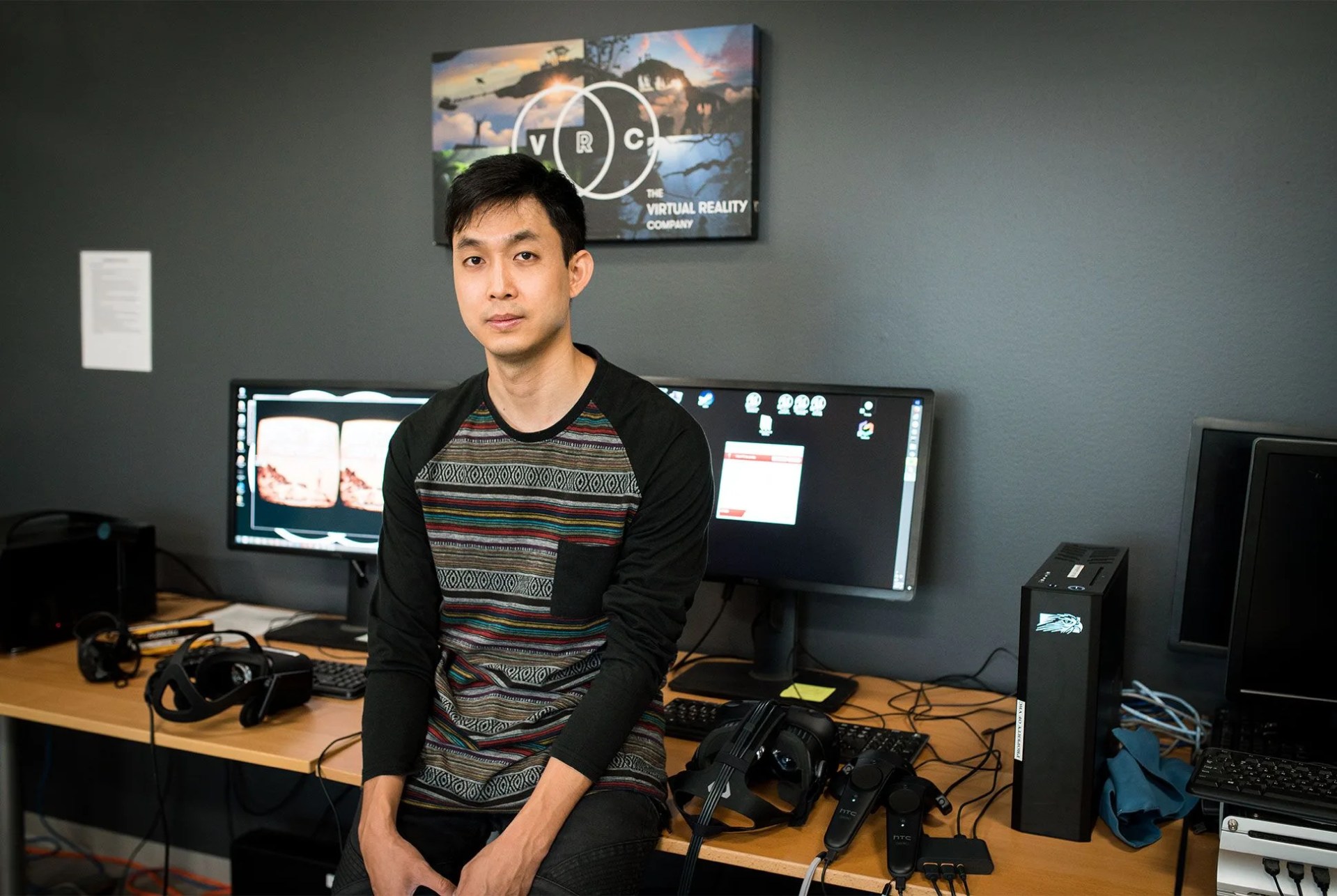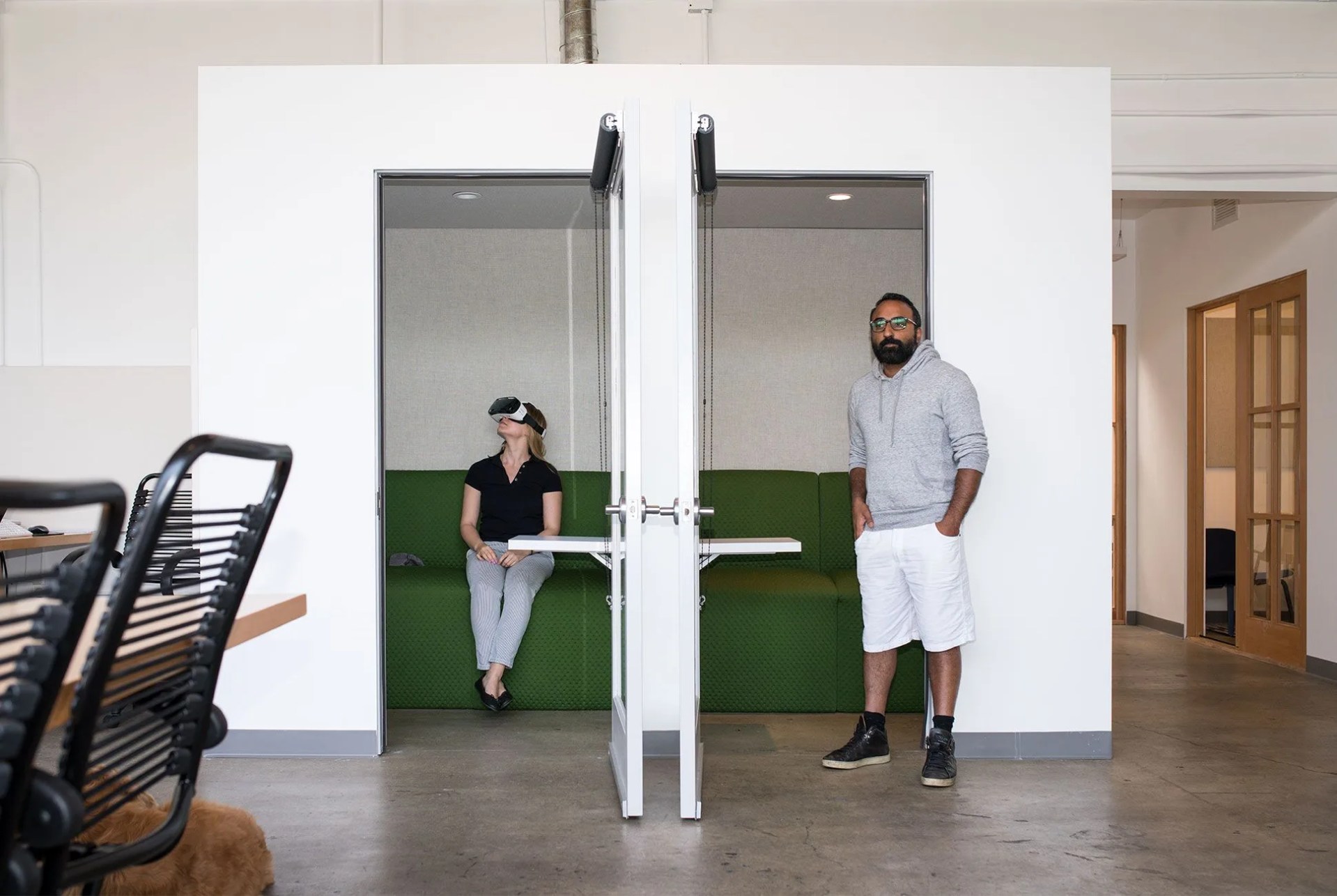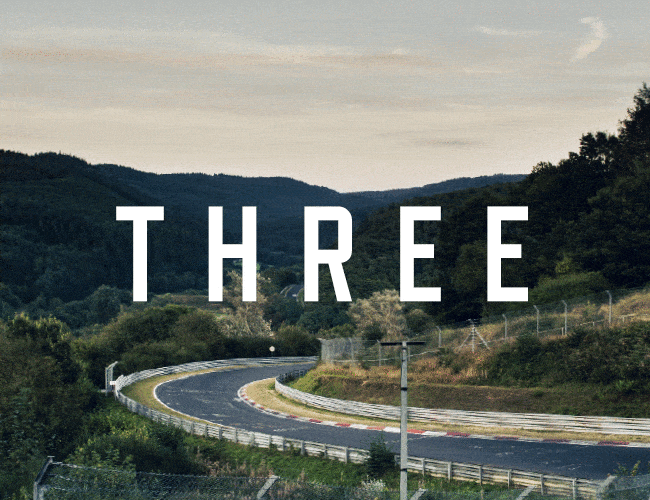From Issue Three of the Gear Patrol Magazine.
Discounted domestic shipping + 15% off in the GP store for new subscribers.
Andy Vick swiveled slowly in his office chair, arms outstretched, hands grasping at the air around him. We’re in a dark room in the virtual-reality production studio he co-founded, Surreal. The company — which just that day announced its acquisition by STX Entertainment, a fast-growing multimedia empire — sits in an office tower in Burbank, just over the Santa Monica Mountains from downtown Los Angeles, on the flipside of the Hollywood Sign.
Though we were surrounded by virtual-reality goggles — Oculus Rifts, HTC Vives, Samsung Gear VRs, Google Cardboards — and Vick looked for all the world like he actually was deep inside some VR universe being showered by snowflakes, butterflies, or maybe exploded body parts, there was no headgear covering his eyes. He was simply gathering his thoughts, spinning absent-mindedly while struggling to articulate the future of an industry so young that it truly has no playbook whatsoever.
“The language of making something in virtual reality — the alphabet — it doesn’t even exist yet,” Vick mused, stopping his pirouetting pedestal just long enough to make eye contact. “People are trying to figure out how to do it, but literally the letters don’t exist.”
VR needs to move from San Francisco to Los Angeles, where dreams and excitement and emotions rake in the money, not just impressive hardware specs.
That’s a problem, because virtual reality — the Next Big Thing — needs Hollywood studios like his to put the pedal to the metal and generate original, compelling VR-based entertainment, or it risks fading from public consciousness like 3D TV, or lingering forever in the gamersphere. The latter’s a lucrative market, to be sure, and VR is having a banner launch year with that as its locus, alongside the release of both Oculus Rift and the similarly powerful HTC Vive goggles and hundreds of games and VR experiences. With this hardware, you can engage in immersive experiences right in your living room, including climbing a steep cliff, floating around in a space station, racing cars, and even becoming a garage mechanic or short-order cook. Job Simulator is surprisingly satisfying. But in order for the technology to truly take off — for it to shoot past clunky goggles and the expensive gaming rigs needed to run them — it absolutely needs to appeal to the mass market. It’s not going to be video games that does that, or even jaw-dropping simulations of mountains and space. It’s going to be a whole new brand of narrative entertainment.
In short, VR needs to move from San Francisco, where Mark Zuckerberg pulls all the strings (Facebook essentially birthed the contemporary VR movement by acquiring Oculus for $2 billion in 2014) to Los Angeles, where dreams and excitement and emotions rake in the money, not just impressive hardware specs. It needs to be crafted and shaped into something that draws people in and doesn’t let them go. Think: you-are-there versions of Breaking Bad, Lost, or The Walking Dead, in much shorter bites. There aren’t many studios working on such content yet, but they’re quickly capturing the dollars and the talent to make it happen. Surreal’s acquisition by STX was a big endorsement of the medium; Steven Spielberg is collaborating with The Virtual Reality Company, creators of The Martian VR Experience, on new projects; and the format has received two Emmy Awards, one for Best User Experience and Visual Design (Sleepy Hollow, 2015) and one for Outstanding Original Interactive Program (Henry, 2016).

That alone should whet Hollywood’s appetite, it being the voracious consumer and regurgitator of all things new and exciting. But while there’s great enthusiasm for the medium, there’s also great caution, for many legitimate reasons. The hardware, at the moment, is expensive and often complicated to set up and use. (Oculus Rift costs $600, but you need a hardcore gaming PC to run it, and those typically start at $1,000.) That severely limits your potential audience, and therefore your potential revenue. Also, VR is largely solitary, so you can’t really gather with friends and family to share an experience. Then there’s the looming narrative-strategy issue. Unfortunately, Vick wasn’t exaggerating when he said that nobody really knows how to do this yet. It’s one thing to make video games for VR — everything can be first-person POV, with computer-generated worlds and landscapes to navigate — but actual narrative content, where you have to lead the viewer through a story but also allow for their own propensity for looking around and exploring, is a different matter altogether. “You can’t just take any director and say, ‘You’re going to make VR now!’” Vick said. “Directors all have a visual language that they can pull from — a bunch of shots they fall back on that they love. But none of that works in VR. You need to do it differently; you need a language and technique that’s completely new.”
“You need to do it differently; you need a language and technique that’s completely new.”
But once you do crack that code, the results in virtual reality represent truly next-level engagement. Watching Henry — the Emmy-winning short animated feature from Oculus’s in-house production company, Oculus Story Studio, about a lonely hedgehog named, naturally, Henry — you really are there in the room with him. When you take a moment to look around and explore, then look back at him and realize he’s noticed you, a shiver runs down your spine. If you were to watch Henry on a regular widescreen format, it simply wouldn’t be the same. In VR, you’re beside him, sharing his struggle and cheering him on. In The Martian VR Experience, you are Matt Damon’s Mark Watney, struggling to stay alive. When you take off your goggles, you feel a tinge of disappointment that you’re suddenly back in your living room, not on Mars. It’s similar to the post-movie experience, only the transition is much more intense in VR.
The possibilities for striking nerves like that — via the viewer being an actual presence in the story — are limitless, and that is exactly the special sauce that VR creators in Hollywood need to concoct. “If you as a viewer represent a character in the story with different emotional elements attached to character, you’re not just watching through a window, you’re actually embodying them,” said writer and director Jinder Ho, The Virtual Reality Company’s storyteller-in-residence. “So we have to ask questions that aren’t usually asked in cinema. Maybe you’re the main character; maybe you’re the supporting character. Do we do close-ups, or violate personal space? What are the viewer’s own limitations? Some people might not like being up close to characters, cheek to cheek, but you can use that to your advantage by making them uncomfortable, and then playing on that emotion. VR creators need to be really aware of that stuff from the outset.”
I met Ho at VRC’s office on Wilshire, which is similarly strewn with headsets and high-powered computers. We chatted on the patio of the company’s bright, airy office overlooking a modest sliver of Los Angeles. The company, founded by Maleficent director and visual effects artist Robert Stromberg, recently raised $23 million in funding, and is now hard at work on multiple VR projects, including Spielberg’s “family-friendly” project, currently undisclosed. Ho said the team is pulling from all quarters of the entertainment industry to bring their narratives to life inside the headsets. In addition to writers and directors, its tech team is infused with talent from gaming sectors, as well. “That’s a nice merger you get with VR,” he noted. “Games are usually ninety percent interactive with cut scenes to move the story forward, and VR opens up that spectrum. The Martian has a lot of interactivity, with equal amounts passive and interactive portions, with Matt Damon telling you the story. Is that the optimal storytelling experience? Maybe, maybe not. There’s no definitive answer to what is the quintessential VR story.”
“Fifty years from now, this is what film will be, and the idea of film as we know it now is going to feel like a steam-engine ship.”
But there is a definitive emotion: empathy. It’s a word everyone I spoke with came back to frequently. The fact is, when you place viewers inside a story — literally — it becomes a shared experience. “What VR has that traditional media doesn’t is empathy and presence,” said filmmaker Samir Mallal, who in 2015 created New Wave, the first VR film to feature dynamically changing voiceovers from different characters. “It’s how we seduce our viewer and pull them into the story. That’s what’s going to make people want to put on a big clunky headset. There are a lot of narrative challenges around that — what’s the presence and how is it connected to the character? — but ultimately storytelling is storytelling, and stories are how we process our emotions. That hasn’t changed in our brains in three thousand years.”

He noted that the thing that will move VR farther along than other attempts at entertainment disruption (most recently 3D television, which also required goggles), is the fact that experiential content is much more of a logical evolution for entertainment. “The technology is here and it’s too big to fail. It’s already a billion-dollar industry on the hardware alone,” Mallal said. “Now, going forward, everything will be this in some form or another. Fifty years from now, this is what film will be, and the idea of film as we know it now is going to feel like a steam-engine ship. So why do all this if it’s not fundamentally different? It’s not worth the time or the effort.”
Mallal, who works with the visionary production company Missing Pieces, is developing a narrative crime thriller in VR, with short episodes likely under 10 minutes each. Brevity is key right now, since the Oculus and HTC gear is indeed a noticeable presence on your head, and viewers likely won’t be able to stay engaged for long, at least until they get used to wearing headsets (and several generations of hardware have moved the tech along). So yet another challenge will be packing narratives into shorter chapters than you have on conventional television, which typically run for 22 or 44 minutes each. (That said, The Martian VR Experience was 20 minutes long, and Ho said that viewers usually stayed for the duration.) In this respect, VR has its own advantage: the viewer is so keenly engaged, so absolutely present in the experience, that you can compress and shape content differently. You can tell an equivalent story in a shorter period of time, in the same way that a great music video can do so much in such a short period of time. (Music videos are also going to be revolutionized by VR, everyone I spoke to agreed.)
Directors will also have to remember that their audiences have a degree of autonomy. They’re partnered with the director and immersed in the story, but they have latitude about where to look and even go, depending on how the experience is constructed. In this way, noted Max Planck, the supervising technical director of the Oculus Story Studio, creators can learn a lot from a surprising source: magicians. “They’re experts at controlling attention,” he said. “By controlling your attention, they’re able to turn the tables on you. In the same way, VR productions must accept that viewers have agency, but use that agency to improve the storytelling.”
Planck and the others at Oculus are, of course, doing everything they can to encourage creative talent to embrace the new medium. Henry’s Emmy will go a long way in that respect, as will the raft of content they’re encouraging from all sectors, whether gaming or 360-degree documentaries and concerts. Beyond that, however, all they can do is step back and let the magicians do their work.
Read More in Our Magazine

A version of this story appears in Issue Three of the Gear Patrol Magazine, 320 pages of stories, reports, interviews and original photography from five distinct locations around the world. Subscribe Now: $39
